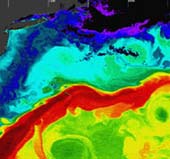Oceanographers in noble pursuit

The warm gulf stream (red) as it travels across the Atlantic. <br>© RSMAS <br>
Argon traces keep tabs on climate change.
A new method for detecting tiny quantities of a rare form of the element argon may help oceanographers to trace the vast undersea currents that regulate our planet’s climate.
The technique can pick out one atom of the rare isotope argon-39 (39Ar) amid 10 million billion other atoms. That’s equivalent to detecting less than a litre of water in America’s 300-mile Lake Michigan.
Philippe Collon, a nuclear physicist at the Lamont-Doherty Earth Observatory in Palisades, New York, and his colleagues modified a particle accelerator at Argonne National Laboratory near Chicago to find and count 39Ar atoms. Counting 39Ar “is decidedly tricky”, says Collon. His team are still perfecting their technique.
Previous efforts to count 39Ar atoms in seawater required thousands of litres of water and months of processing. Collon’s technique should be able to measure the isotope’s concentration in about 10 litres of water in a few hours.
Ideal gas
Rare 39Ar is produced in the atmosphere by cosmic rays hitting ordinary 40Ar – it then dissolves into the sea. Because the isotope decays at a fixed rate, the amount that remains at different depths tells researchers how long it has been since the water was last at the surface.
If the team can provide a reliable way to measure 39Ar, samples from the deep ocean could begin to yield new clues about the huge currents of the Great Ocean Conveyor Belt, and whether they are changing over time.
The conveyor belt is a giant loop that spans most of the world’s oceans – cold water moves from north to south along the sea floor, whereas warm water travels the other way at the surface. A complete cycle takes about 1,000 years.
The water in the conveyor belt carries much of the Earth’s heat, making it crucial to climate. Melting ice after the most recent Ice Age is thought to have halted the conveyor, causing sudden and massive shifts in climate. Some climatologists worry that melting of ice caps as a result of global warming could have the same effect.
The half-life of 39Ar – 269 years – “falls into a timescale that’s very useful for measuring climate change”, says Bill Jenkins, who studies ocean circulation at the University of Southampton, UK.
Even better, Jenkins adds, argon is biologically inert. The movement of radioactive carbon in the bodies of plants and animals have confused previous ocean studies using that element.
But argon “doesn’t solve all of oceanography’s problems”, warns Jenkins. There is still some question as to whether 39Ar is produced at a constant rate in the atmosphere. If it isn’t, fluctuations measured in the ocean may not have a direct bearing on ocean circulation.
Media Contact
More Information:
http://www.nature.com/nsu/020114/020114-14.htmlAll latest news from the category: Earth Sciences
Earth Sciences (also referred to as Geosciences), which deals with basic issues surrounding our planet, plays a vital role in the area of energy and raw materials supply.
Earth Sciences comprises subjects such as geology, geography, geological informatics, paleontology, mineralogy, petrography, crystallography, geophysics, geodesy, glaciology, cartography, photogrammetry, meteorology and seismology, early-warning systems, earthquake research and polar research.
Newest articles

High-energy-density aqueous battery based on halogen multi-electron transfer
Traditional non-aqueous lithium-ion batteries have a high energy density, but their safety is compromised due to the flammable organic electrolytes they utilize. Aqueous batteries use water as the solvent for…

First-ever combined heart pump and pig kidney transplant
…gives new hope to patient with terminal illness. Surgeons at NYU Langone Health performed the first-ever combined mechanical heart pump and gene-edited pig kidney transplant surgery in a 54-year-old woman…

Biophysics: Testing how well biomarkers work
LMU researchers have developed a method to determine how reliably target proteins can be labeled using super-resolution fluorescence microscopy. Modern microscopy techniques make it possible to examine the inner workings…





















